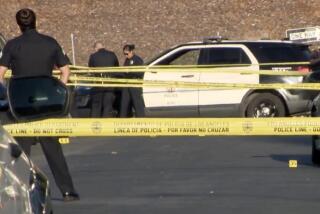Trial Starts in Howard Beach Race Clash
- Share via
NEW YORK — A special prosecutor charged Wednesday that a group of white teen-agers watched an auto kill a 23-year-old black man they had chased into traffic on a busy highway and then, “without missing a beat,” went on to beat one of his companions, whose mercy pleas they ignored.
More than nine months after the quiet Queens neighborhood of Howard Beach was turned into a national symbol of urban racial violence, trial opened for four defendants charged with causing the death of Michael Griffith and the beatings of two of his companions.
The case of the three black men who were assaulted when their car broke down near Howard Beach heightened racial tensions in other parts of New York City as well.
Special New York state prosecutor Charles J. Hynes told the jury in his opening statement that three of the defendants watched the car hurl Griffith “12 to 15 feet into the air,” then raced down another street to beat Cedric Sandiford, who pleaded with his attackers: “I have a son like you, 17 years old. Don’t kill me.”
“The response,” Hynes added, “was to slam a baseball bat into his face.”
Hynes said that Griffith ran onto the Belt Parkway because he saw no other way of fleeing his attackers. The prosecutor said that, as Griffith raced down a narrow fence-lined street, the street “became in every sense a tunnel, the only escape from which became to put the traffic on the Belt Parkway between himself and his pursuers.”
Four Howard Beach teen-agers are on trial in the case. Jon Lester and Scott Kern, both 18, are charged with second-degree murder. Jason Ladone, 16, and Michael Pirone, 17, are accused of manslaughter. Eight others are to be tried later on lesser charges.
Both Sandiford, 36, and Timothy Grimes, 20, who were attacked by the group, are expected to be important witnesses for the prosecution, as is Robert Riley, 18, who was originally charged with murder and manslaughter. Riley has pleaded guilty to assault and is cooperating with prosecutors.
A central issue facing the jury will be precisely what happened in the moments leading up to Griffith’s death early last Dec. 20. The jurors will have to decide between two very different portraits of the men whose car broke down and who stopped for pizza in Howard Beach.
In their opening statements, defense lawyers cautioned against a “rush to judgment,” arguing that the three men who were pummeled by bats, fists and a tree limb “were looking for a fight” and were not “three lambs walking into Sodom.” Two of the men, the lawyers charged, pulled knives.
Defense lawyers suggested that Griffith might have to some degree caused his own death, alleging that he was high on cocaine.
Pirone’s lawyer, Stephen J. Murphy, told the jury that Griffith had cocaine in his body when he died. Justice Thomas A. Demakos immediately questioned that statement.
“You’re going to prove that?” the judge asked.
“Yeah,” Murphy answered.
The lawyer charged also that the three men had been in two other disputes earlier in the evening. “Sandiford and Grimes had a knife on them, and these knives were pulled out at the scene,” Murphy alleged. “These guys had two arguments earlier.
“Mr. Hynes does not have three angels here,” he added.
The special prosecutor took jurors through his version of what happened in Howard Beach. He said that, as the three black men walked towards a pizzeria, they were met by an auto with its horn blaring and lights flashing on and off. Strong racial epithets flew from both sides.
Later, Hynes charged, Lester, who was in the car, returned to a party and called for other teen-agers to attack the intruders. Reading from the grand jury’s indictment, the prosecutor said that the attackers showed a “depraved indifference to human life.”
Jury selection took five weeks and was marked by controversy. Prosecutors charged that defense lawyers were systematically excluding blacks from the jury. Finally, Justice Demakos agreed and ordered the defense to provide non-racial explanations when seeking to dismiss potential jurors.
The panel, including four alternates, that was finally selected is made up of two blacks, seven whites, two Asian Americans, three Latinos, a Caribbean-American and a native of Guyana of Indian descent.
More to Read
Sign up for Essential California
The most important California stories and recommendations in your inbox every morning.
You may occasionally receive promotional content from the Los Angeles Times.













